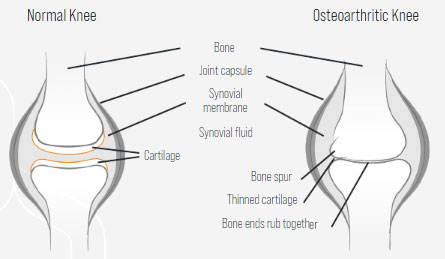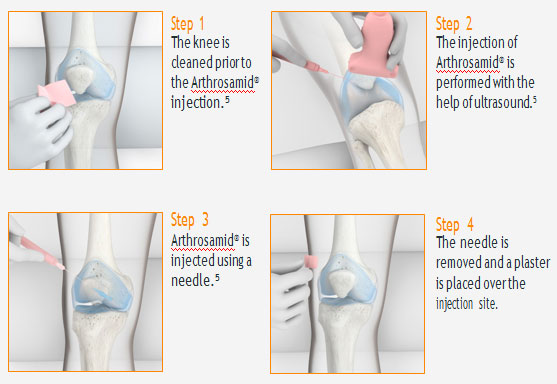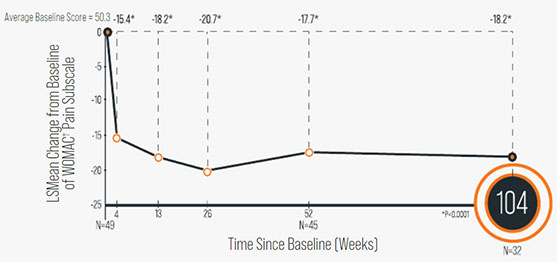What is osteoarthritis?
Osteoarthritis is a long term condition which affects the joints and worsens over time, causing pain and disability. It is most common in the knee joint,² where it wears away the shock-absorbing cartilage, causing bones to rub together and the joint to become stiff, swollen and painful. Around 1 in 5 people aged over 45 in England is affected by knee arthritis.3

The cause of osteoarthritis is unknown. There is no permanent cure and, until now, treatments have focused on managing the symptoms. They include:
- Exercise
- Weight loss
- Pain relief medication (including prescription-only opioids and off-label corticosteroid injections)
- Knee injections with viscosupplements
- Surgery such as joint osteotomy or knee replacement
Apart from knee replacement surgery, these therapies cannot deliver long-term benefits.
What is Arthrosamid® ?
Arthrosamid® is a new type of treatment for knee osteoarthritis that offers patients an effective alternative to the currently available therapies.1 Based on an innovative non-biodegradable hydrogel technology, Arthrosamid® is 97.5% water with 2.5% being a cross linked polyacrylamide backbone. When injected into the knee Arthrosamid® cushions the joint and reduces pain, providing safe and sustained relief, all with one injection.1
How is Arthrosamid® administered?
Arthrosamid® is given as a single injection into the knee’s intra-articular cavity by a qualified specialist – either an orthopaedic surgeon or rheumatologist. Before you are given an Arthrosamid® injection, you will have a local anaesthetic, which may sting a little, to numb the area around your knee. Unlike surgery, the injection is a minimally invasive procedure that you can receive as an outpatient.⁴ Before the injection, you should be given antibiotics to protect you from any potential risk of infection.

How does it work?
Arthrosamid® is an intra-articular polyacrylamide hydrogel injection for the symptomatic treatment of knee osteoarthritis. Once injected into the inner joint cavity, it restores viscosity within the synovial fluid, improving lubrication and cushioning of the joint. Arthrosamid® also integrates into the synovium of the inner joint capsule creating a cushion-like effect.
What are the benefits?
As Arthrosamid® works to cushion the joint, it can reduce your pain, decrease stiffness, and help movement.1,6-9 The hydrogel itself does not degrade and therefore it provides long-acting relief, improving your quality of life.¹ In clinical trials, patients reported a significant reduction in their pain symptoms by week 4 after their injection and, unlike other injectable treatments, the level of reduction was maintained at the 2-year follow up period.10
A 2-year Prospective Study (IDA).9,10

† WOMAC or The Western Ontario and McMaster Universities Osteoarthritis Index is a measure of symptoms and physical disability.
LSMeans are modelled/estimated means. The estimated means are using data from the other visits and also the covariates.
What are the side effects?
In a number of clinical trials with Arthrosamid®, there were no serious side effects related to the hydrogel. The most commonly reported side effects were mild to moderate injection site pain and swelling, which were generally transient in nature. The overall safety profile of the hydrogel has been established over the last 20 years with its use for various indications in the body.
Is Arthrosamid® right for me?
Arthrosamid® is approved for the symptomatic treatment of knee osteoarthritis so any patient with this condition may be suitable. Over the last 10 years many patients have benefitted from treatment with the hydrogel in Arthrosamid®. However treatment with Arthrosamid® may not be suitable for everyone. Your doctor is the best person to advise you, but situations where you should not use Arthrosamid® (contraindications) include*:
- If you have an infection at or near the injection site
- If you have haemophilia or take anticoagulant treatment
- If you have had a knee arthroscopy within the past 6 months
Additionally, your doctor may advise you not to have treatment with Arthrosamid® if your diabetes is poorly controlled, you are having major dental work, or you have been diagnosed with an autoimmune disorder, (such as Multiple Sclerosis, Addison’s, or Coeliac disease). If you are under 18, pregnant, breastfeeding, or have a foreign body in your knee, your doctor may advise against the injection. This is because the safety and effectiveness of Arthrosamid® has not yet been established in these groups.
*This is not a full list of contraindications. Please refer to your healthcare professional, or see Arthrosamid›s indications and contraindications on the back page.
How does Arthrosamid® differ from other injectable treatments?
Arthrosamid® is different from the viscosupplement injections for the knee such as hyaluronic acid (HA), platelet rich plasma (PRP) and regenerative stem cell therapy. Unlike these treatments, Arthrosamid® is a non degradable hydrogel which means it has the properties to lubricate and cushion for longer. Unlike the other treatments, Arthrosamid® also has the ability to become an integrated part of the soft synovial tissue in the joint capsule which may lead to longer lasting pain relief. 5
Take the next step in controlling your knee OA pain
Knee osteoarthritis can be a debilitating condition impairing your quality of life. Over-the-counter painkillers or lifestyle changes to diet and exercise are often not enough. Talk to your doctor about Arthrosamid®.
SAFE AND SUSTAINED PAIN RELIEF WITH A SINGLE INJECTION¹
For more information, read the Instructions for Use (IFU) for full details about Warnings and Precautions. The IFU is also available from https://www.arthrosamid.com or info@arthrosamid.com
INDICATIONS, PATIENT GROUP AND USAGE
Arthrosamid® is intended to be used for symptomatic treatment of adult patients with knee osteoarthritis.
CONTRAINDICATIONS5
Arthrosamid® should not be injected:
- If an active skin disease or infection is present at or near the injection site
- If the joint is infected or severely inflamed
- If the patient has previously received treatment with a different non-absorbable injectable/implant - If the patient has received a knee alloplasty or has any foreign material in the knee
- If the patient has undergone knee arthroscopy within the last 6 months
- In haemophilia patients or in patients in uncontrolled anti-coagulant treatment
- Bliddal H, Overgaard A, Hartkopp A, Beier J, Conaghan PG, et al. (2021) Polyacrylamide Hydrogel Injection for Knee Osteoarthritis: A 6 Months Prospective Study. J Orthop Res Ther 6:
- Jorge L. Escobar Ivirico, Maumita Bhattacharjee, Emmanuel Kuyinu, Lakshmi S. Nair, Cato T. Laurencin, Regenerative Engineering for Knee Osteoarthritis Treatment: Biomaterials and Cell-Based Technologies, Engineering, Volume 3, Issue 1,2017, P16-27.
- Public Health Available at: https://www.versusarthritis.org/media/13374/birmingham-oa-1.pdf. Accessed 23 03 2021.
- Goldman, T., Piechowiak, R., Nissman, D., Bagla, S., Isaacson, A., 2018. Current Concepts and Future Directions of Minimally Invasive Treatment for Knee Pain. Current rheumatology reports 20, 54.
- Arthrosamid, Instructions For Release Date March 2022 10083-002.
- Christensen, , Daugaard, S., 2016. Histological Appearance of the Synovial Membrane after Treatment of Knee Osteoarthritis with Polyacrylamide Gel Injections: A Case Report. Journal of Arthritis 5, 217.
- Tnibar, A., Schougaard, H., Camitz, L., Rasmussen, J., Koene, M., Jahn, W., Markussen, B., 2015. An international multi-centre prospective study on the efficacy of an intraarticular polyacrylamide hydrogel in horses with osteoarthritis: a 24 months follow-up. Acta veterinaria Scandinavica 57,
- Christensen, , Camitz, L., Illigen, K.E., Hansen, M., Sarvaa, R., Conaghan, P.G., 2016. Synovial incorporation of polyacrylamide hydrogel after injection into normal and osteoarthritic animal joints. Osteoarthritis and cartilage / 24, 1999-2002.
- Data on
- Bliddal, , et al. (2022). A Prospective Study of Polyacrylamide Hydrogel Injection for Knee Osteoarthritis: Results From 2 Years After Treatment. Poster presented at OARSI 2022.
OUS/ARTHRO/AUG2022/099
